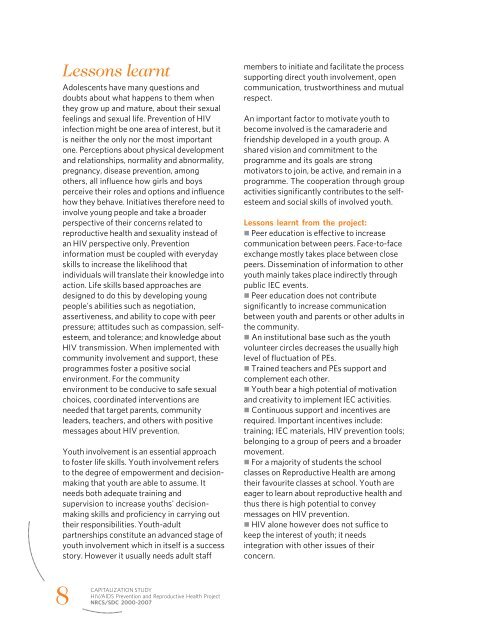HIV/AIDS Prevention & Reproductive Health Project
HIV/AIDS Prevention & Reproductive Health Project
HIV/AIDS Prevention & Reproductive Health Project
You also want an ePaper? Increase the reach of your titles
YUMPU automatically turns print PDFs into web optimized ePapers that Google loves.
Lessons learnt<br />
Adolescents have many questions and<br />
doubts about what happens to them when<br />
they grow up and mature, about their sexual<br />
feelings and sexual life. <strong>Prevention</strong> of <strong>HIV</strong><br />
infection might be one area of interest, but it<br />
is neither the only nor the most important<br />
one. Perceptions about physical development<br />
and relationships, normality and abnormality,<br />
pregnancy, disease prevention, among<br />
others, all influence how girls and boys<br />
perceive their roles and options and influence<br />
how they behave. Initiatives therefore need to<br />
involve young people and take a broader<br />
perspective of their concerns related to<br />
reproductive health and sexuality instead of<br />
an <strong>HIV</strong> perspective only. <strong>Prevention</strong><br />
information must be coupled with everyday<br />
skills to increase the likelihood that<br />
individuals will translate their knowledge into<br />
action. Life skills based approaches are<br />
designed to do this by developing young<br />
people's abilities such as negotiation,<br />
assertiveness, and ability to cope with peer<br />
pressure; attitudes such as compassion, selfesteem,<br />
and tolerance; and knowledge about<br />
<strong>HIV</strong> transmission. When implemented with<br />
community involvement and support, these<br />
programmes foster a positive social<br />
environment. For the community<br />
environment to be conducive to safe sexual<br />
choices, coordinated interventions are<br />
needed that target parents, community<br />
leaders, teachers, and others with positive<br />
messages about <strong>HIV</strong> prevention.<br />
Youth involvement is an essential approach<br />
to foster life skills. Youth involvement refers<br />
to the degree of empowerment and decisionmaking<br />
that youth are able to assume. It<br />
needs both adequate training and<br />
supervision to increase youths' decisionmaking<br />
skills and proficiency in carrying out<br />
their responsibilities. Youth-adult<br />
partnerships constitute an advanced stage of<br />
youth involvement which in itself is a success<br />
story. However it usually needs adult staff<br />
members to initiate and facilitate the process<br />
supporting direct youth involvement, open<br />
communication, trustworthiness and mutual<br />
respect.<br />
An important factor to motivate youth to<br />
become involved is the camaraderie and<br />
friendship developed in a youth group. A<br />
shared vision and commitment to the<br />
programme and its goals are strong<br />
motivators to join, be active, and remain in a<br />
programme. The cooperation through group<br />
activities significantly contributes to the selfesteem<br />
and social skills of involved youth.<br />
Lessons learnt from the project:<br />
• Peer education is effective to increase<br />
communication between peers. Face-to-face<br />
exchange mostly takes place between close<br />
peers. Dissemination of information to other<br />
youth mainly takes place indirectly through<br />
public IEC events.<br />
• Peer education does not contribute<br />
significantly to increase communication<br />
between youth and parents or other adults in<br />
the community.<br />
• An institutional base such as the youth<br />
volunteer circles decreases the usually high<br />
level of fluctuation of PEs.<br />
• Trained teachers and PEs support and<br />
complement each other.<br />
• Youth bear a high potential of motivation<br />
and creativity to implement IEC activities.<br />
• Continuous support and incentives are<br />
required. Important incentives include:<br />
training; IEC materials, <strong>HIV</strong> prevention tools;<br />
belonging to a group of peers and a broader<br />
movement.<br />
• For a majority of students the school<br />
classes on <strong>Reproductive</strong> <strong>Health</strong> are among<br />
their favourite classes at school. Youth are<br />
eager to learn about reproductive health and<br />
thus there is high potential to convey<br />
messages on <strong>HIV</strong> prevention.<br />
• <strong>HIV</strong> alone however does not suffice to<br />
keep the interest of youth; it needs<br />
integration with other issues of their<br />
concern.<br />
8<br />
CAPITALIZATION STUDY<br />
<strong>HIV</strong>/<strong>AIDS</strong> <strong>Prevention</strong> and <strong>Reproductive</strong> <strong>Health</strong> <strong>Project</strong><br />
NRCS/SDC 2000-2007

















